Updated: September 12, 2025
Written by Dan Simms
Nieves is a home remodeling editor at Fixr.com with special interest in landscaping, pest control, painting, installation, and repair projects. She brings her work ethic, creativity, and love for teamwork into everything she does, including working with writers and designers at Fixr.com to develop useful and comprehensive guides for homeowners.
Learn moreReviewed by Nieves Martinez
Casement windows are the most energy-efficient type of functional window, and they offer unobstructed views of the outdoors and better ventilation than any other style. Replacing your existing casement windows is a great home improvement project that can help reduce heating and cooling costs and boost your home’s curb appeal, which can have a major positive impact on value.
Replacing a casement window costs between $400 and $1,200, in most cases, but prices can range from $200 to $2,400, depending mostly on the size, frame material, and glass options. Where you’re installing the casement window, the brand, and where you live can also affect your costs. For a standard-size casement window with a vinyl frame and double-pane glass, expect to pay an average of $730.
Cost to Replace Casement Windows

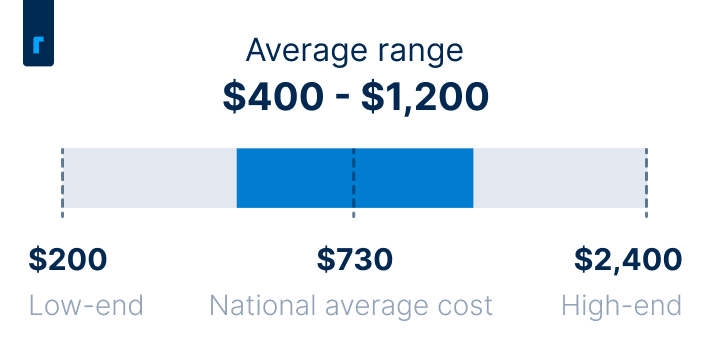
Cost to Install a Casement Window by Size
The size of the casement window you install directly impacts both your material and labor costs. Larger windows require more materials, increasing the overall price. For labor, costs can also rise for oversized windows because they often require multiple technicians to install, and in some cases, may even need structural modifications to your home.
While the average casement window size is 2 to 3 feet wide and 3 to 4 feet tall, sizes can vary greatly depending on the room. Smaller windows are typically used in bedrooms and bathrooms for privacy, while larger windows are more common in living and dining rooms to provide a clearer view and let in more natural light. Keep in mind that while most window manufacturers offer custom sizing, it will come at a higher price.
You can use the table below to get an idea of what your casement window will cost based on the size you need, assuming you go with the standard material (vinyl) and glass options (double-pane).
Window Size (Inches) | Avg. Window Cost (Installed) |
24x36 | $290 – $480 |
24x48 | $380 – $640 |
24x60 | $480 – $800 |
30x36 | $360 – $600 |
30x48 | $480 – $800 |
30x60 | $600 – $1,000 |
36x36 | $430 – $720 |
36x48 | $575 – $960 |
36x60 | $720 – $1,200 |
Casement Window Replacement Cost Factors
Casement window prices can fall anywhere from $200 up to $2,400, and there are a few key factors that determine where in that price range your total will fall. The type of glass you choose, the frame material, the window size, and the glass treatments you choose are the most crucial cost factors to consider.
Casement Window Installation Cost by Type
There are a few different types of casement windows you can purchase, and the one you need for your home will play a major role in your total costs.

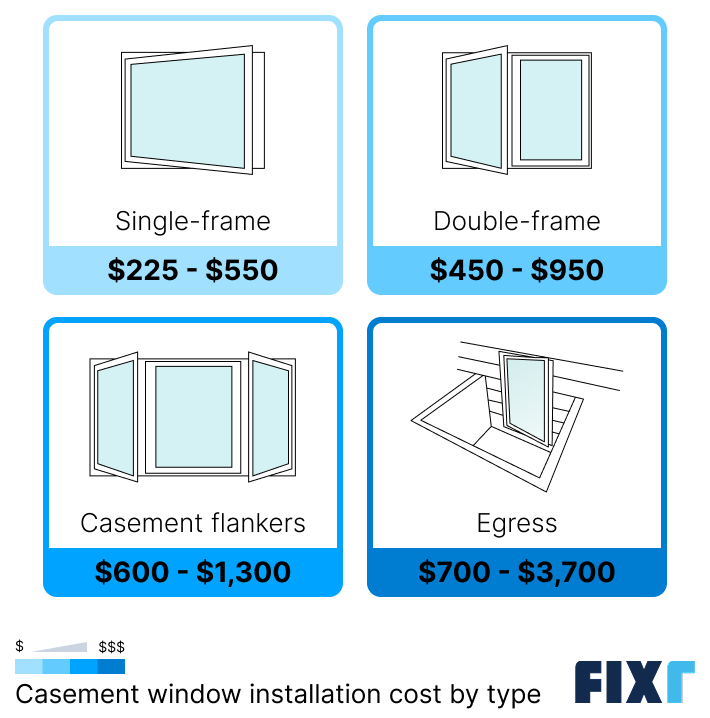
Type of Casement Window | Replacement Cost |
Single-frame | $225 – $550 |
Double-frame | $450 – $950 |
Picture window with casement flankers | $600 – $1,300 |
Egress | $700 – $3,700 |
Single-frame casement window
A single-frame casement window consists of a single window in a wall opening, with the sash hinged on one side. This is the most affordable type of casement window to replace, with a cost between $225 and $550 installed. Their lower cost is due to the need for only a single set of opening hardware and less frame material.
Double-frame casement window
Also known as French casement windows, double-frame casement windows are essentially two windows in one opening, hinged on both sides. The two sashes close inward to meet in the middle. The replacement cost for a double-frame casement window is typically $450 to $950 installed, as they require double the hardware and more frame material.
Picture window with casement flankers
A popular setup is to have two casement windows flanking a larger picture window in the middle. This creates a look similar to a bay window, but sits flat against the wall. It is usually best to replace all three windows at the same time. The installed cost for this type of arrangement is between $600 and $1,300.
Egress casement window
An egress casement window is specifically designed for a basement. The single sash opens into a window well and serves as a point of safe exit. Egress casement windows can be either single-frame or double-frame, but single-frame is the more common style. The cost for this type of window is $700 to $3,700 installed.
Casement Window Installation Prices by Frame Material
The frame material you choose for your casement window will also play a crucial role in the overall project cost. Vinyl and aluminum windows are the most affordable options. While they are less insulative and may not have a significant impact on your heating and cooling bills, they also don't add as much to your home's curb appeal or property value.
Composite and fiberglass tend to be the most expensive window frame materials, but they also offer the best insulation and can save you money over time on utility bills. They’re relatively easy to repair, and you can paint them for some customization options.
Wood falls somewhere in the middle in terms of cost and insulative value, but it offers the nicest appearance and can maximize the positive impact your window has on curb appeal and home value. Wood is also easy to repair, stain, and paint for customization.

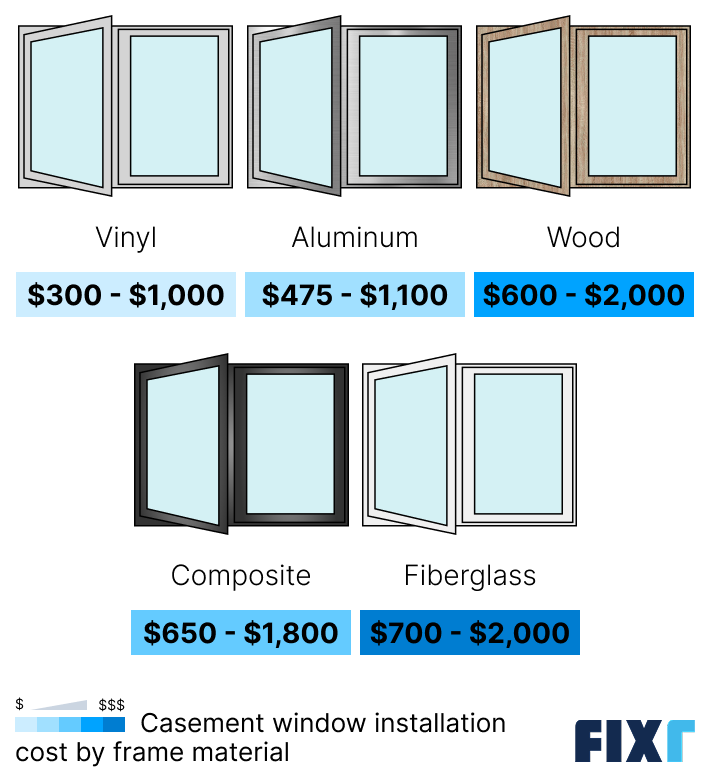
Frame Material | Average Cost (Installed) |
Vinyl | $300 – $1,000 |
Aluminum | $475 – $1,100 |
Wood | $600 – $2,000 |
Composite | $650 – $1,800 |
Fiberglass | $700 – $2,000 |
Average Cost of Casement Window Replacement by Type Of Glass
The type of glass you choose for your casement window will impact both the cost and the window's efficiency. Single-pane glass is the least expensive option but offers minimal insulation. Double-pane glass is the most common choice, featuring two panes with an insulating gas layer, which improves energy efficiency and reduces noise. Triple-pane glass is the most expensive and most efficient option, providing superior insulation and noise reduction, making it ideal for extreme climates.
The following table provides a cost breakdown by glass type, though the final price will also be influenced by the frame material.
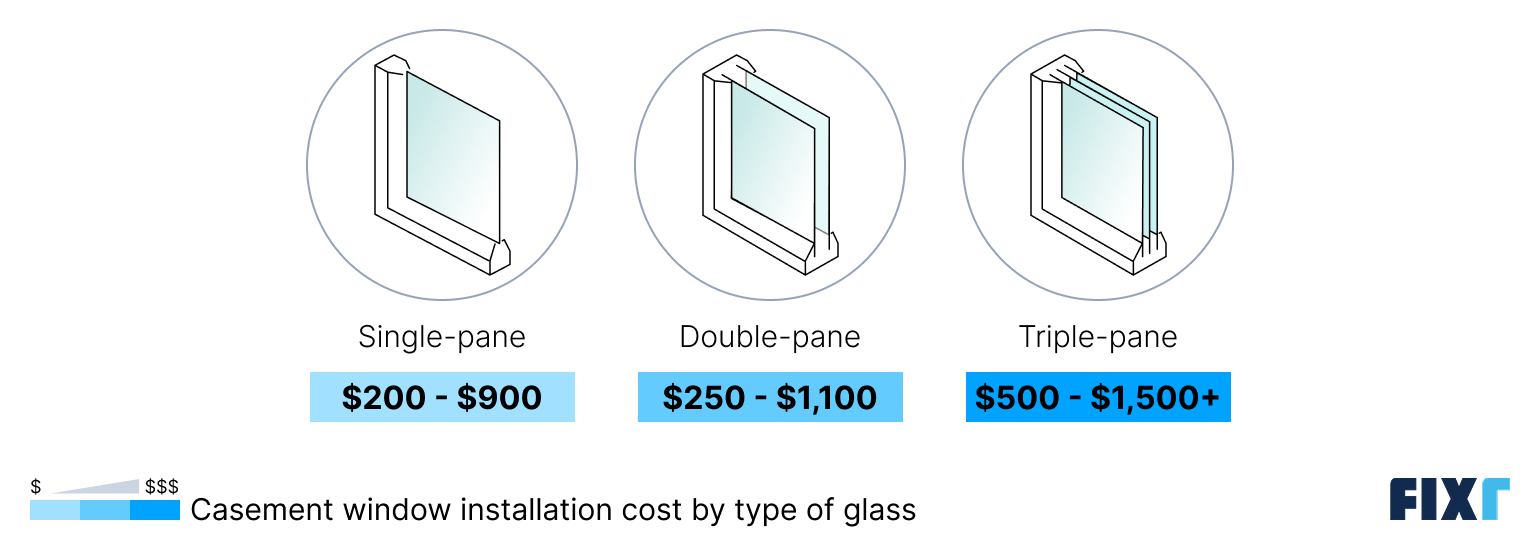
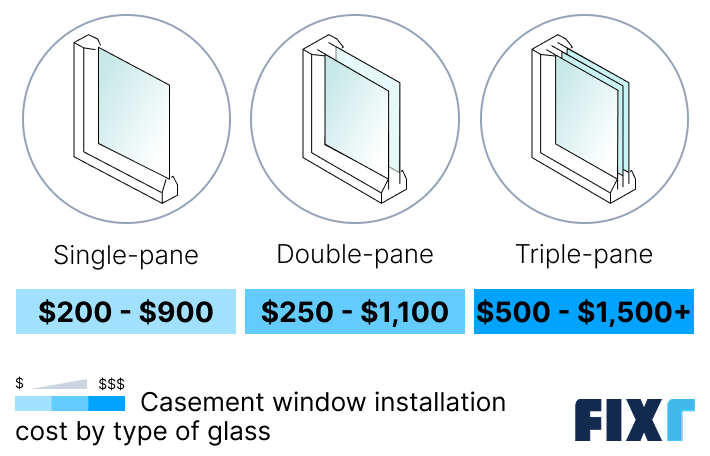
Glass Type | Average Window Cost |
Single-pane | $200 – $900 |
Double-pane | $250 – $1,100 |
Triple-pane | $500 – $1,500+ |
You can also choose from different glass treatment options, which can increase window performance and help maximize your home’s energy efficiency. Low-emissivity (low-E) coatings and reflective coatings can help reduce solar heat gain, making them an energy-efficient option in hotter climates. Window tinting is also helpful in hot, sunny climates, where solar heat gain is an issue.
The different gas options for sealing your laminated window panes can also make a difference when it comes to insulation in both hot and cold climates, with krypton being a significant upgrade from argon, the more common filler gas for double- and triple-pane windows.
Glass Option | Average Cost With Window |
Reflective coating | $230 – $1,000 |
Low-E coating | $250 – $1,300 |
Argon gas fill | $400 – $1,200 |
Krypton gas fill | $530 – $1,700 |
Tinting | $5 – $45/sq.ft. |
Casement Window Installation Labor Cost
The labor for installing casement windows accounts for between 20% and 40% of your total, which comes out to an average of between $80 and $480 for labor alone for a single window. Your labor costs will scale a bit with frame material, with wood and fiberglass frames costing more than aluminum and vinyl due to the weight of the material and how difficult they are to maneuver, but window size has the biggest impact. Larger casement windows will require multiple techs to position and install the window, which can double or triple your labor costs.
Labor costs can also vary based on the number of windows you install. Your installer will include fixed prices for delivery, hauling away your old windows, and travel, so labor costs will decrease per window the more casement windows you’re replacing.
Additional Cost Factors for Casement Windows
Material options and labor are the most important cost factors to consider to get an accurate estimate for your casement window installation, but there are some other minor things that can affect pricing that you should factor in.
Window brand: The brand you choose will have a big effect on your material costs. Brands like Jeld-Wen, Window World, and Milgard can help keep your material costs down, while brands like Andersen, Marvin, and Pella come with higher material costs and will drive up your total.
Energy efficiency: Features like triple-pane glass and insulated frames increase material costs upfront but can lead to long-term savings on utility bills. Keep in mind that some energy efficiency features could make you eligible for rebates and incentives.
Geographic location: Where you live will affect labor costs, which usually scale with the local cost of living. Expect to pay more in major cities than you would in rural areas.
Location in your home: Where in your home you’re installing the new casement window matters, too. Installations for large casement windows on the second floor will come with much higher labor costs due to the need for special equipment and additional labor..
Permits: Permits are often required for new window installations or if you are changing the size of an existing window opening, with costs typically ranging from $50 to $250.
Replacement vs. new installation: Replacing an existing window is less expensive than a new installation, which can add $1,000 to $2,000 to the total cost due to the need for structural changes.
DIY vs. Hiring a Pro
It’s possible to replace a casement window yourself if you stick with the same window size and dimensions, and DIYing will save you between $80 and $480 per window, on average. While the savings can be tempting, it’s always worth hiring a professional when it comes to window replacement, and you’ll need a pro if you’re changing the wall opening dimensions or installing a window where there wasn’t one previously.
Windows act as a first line of defense against the elements, and although the installation process, in theory, is straightforward, it’s easy to make mistakes that can lead to leaks, water damage, and mold growth, as well as air leaks and increased heating and cooling bills. Repair costs and higher utility bills could eventually lead DIY window replacement to cost more over time, even if it’s cheaper initially. Even just the peace of mind that your window is installed properly and will protect your home for years is worth the investment in professional labor.
Finally, many window contractors offer a labor warranty that provides even more peace of mind and protection from damage, and many manufacturers will void their manufacturer warranties if you don’t have a pro carry out the installation. Overall, it’s worth hiring an expert to get the job done properly and get the most protection from your new casement window.
Ways to Save on Casement Window Installation
Casement window installation can get expensive, but there are some things you can do to save upfront on materials and labor, as well as over time on heating and cooling bills, repairs, and potential damages.
Choose your frame material carefully: The frame material you choose is one of the most significant cost factors for casement window replacement. Opt for aluminum or vinyl to keep upfront costs down, but if you live in a more extreme climate, opt for composite or fiberglass windows for long-term savings on energy bills.
Consider your climate when choosing glass options: The same is true for your glass options. Double-pane glass is the industry standard and performs well in most climates, but upgrading to triple-pane could end up saving you money over time in more extreme climates. In hot, sunny climates, you can also consider paying more for reflective glass, low-E glass coatings, or tinting to reduce solar heat gain and save on cooling bills.
Keep your window the same size for replacements: Avoid changing the dimensions of your window opening during a replacement to save on permit and labor costs.
Go with standard sizes if you’re adding a window: If you’re adding a new window, choose a standard casement window size to avoid having to pay extra for custom windows.
Get multiple quotes: Get at least three estimates from window installers in your area, and have each pro price out the same frame material, glass options, and brand. Compare the quotes to find the best window for your budget and avoid unnecessarily high labor costs.
Install your window during the off-season: Schedule your installation for the summer or winter, when installers are less busy, to potentially get lower labor costs.
Take advantage of rebates and incentives: Choosing energy-efficient frame and glass materials could make you eligible for rebates, tax credits, and other incentives, especially if you choose an ENERGY STAR-certified window. Check the Database of State Incentives for Renewables and Efficiency (DSIRE) to see if there are perks available in your area.
Haul away your old window yourself: Finally, offer to haul away your old window rather than paying to have your professional bring it to the dump. This could save you an average of $50 to $60 per window in labor, although you will still need to pay dumping fees yourself, in most cases.
FAQs
Yes, casement windows tend to be more expensive than other types because they have more complex hardware that includes high-quality hinges and internal cranking mechanisms for opening. On average, you can expect to pay a few hundred dollars less per window if you choose picture, awning, single-hung, or double-hung windows. Bay windows and bow windows will almost always be more expensive than casement windows, mostly because they’re larger.
Casement windows are worth it because they’re the most energy-efficient windows, they provide unobstructed views of the outdoors, they let in the maximum amount of sunlight, and they offer the most ventilation. However, they’re more expensive than most other window styles because of the complicated hardware, so think carefully about whether you value upfront cost or long-term enjoyment and value when considering your window options.
In most cases, a professional can replace a casement window in 30 minutes to an hour, but your replacement could take up to six hours if you need structural changes to support a different window size or if you’re installing a window where there wasn’t one previously. Second-story casement window installations will also take a bit longer because of the added challenge of maneuvering the window into place and using safety equipment.
Casement windows are the most energy-efficient type of window that remains operable, so unless you go with a fixed picture window, casement windows will keep your home the most comfortable and lead to lower heating and cooling bills. Casement windows also don’t have individual sash frames that impede sunlight or views of the outdoors, and since the entire sash opens outward, they offer the most ventilation possible. This is a key benefit for homeowners looking for maximum airflow.
